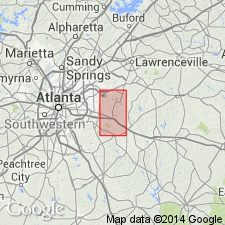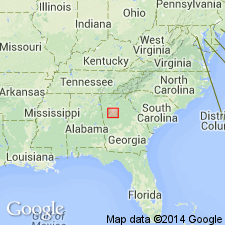
- Usage in publication:
-
- Panola granite
- Modifications:
-
- Named
- Dominant lithology:
-
- Granite
- AAPG geologic province:
-
- Piedmont-Blue Ridge province
Summary:
Name Panola granite introduced in this report. Unit shows no visible structure but has pronounced porphyritic texture formed by small phenocrysts of microcline. Unlike Stone Mountain granite or Lithonia gneiss in structure, texture, and composition. Forms a small prominence known as Hog Mountain south of Panola. Of limited areal extent. Age not given.
Source: GNU records (USGS DDS-6; Reston GNULEX).

- Usage in publication:
-
- Panola Granite*
- Modifications:
-
- Age modified
- Geochronologic dating
- AAPG geologic province:
-
- Piedmont-Blue Ridge province
Summary:
Age of Panola is Carboniferous based on concordant radiometric age date of zircons of 325 m.y. Approximately same age as Stone Mountain Granite. Intrudes Lithonia Gneiss and Clairmont, Wahoo Creek, Clarkston, and Snellville Formations (latter 4 are new names).
Source: GNU records (USGS DDS-6; Reston GNULEX).
For more information, please contact Nancy Stamm, Geologic Names Committee Secretary.
Asterisk (*) indicates published by U.S. Geological Survey authors.
"No current usage" (†) implies that a name has been abandoned or has fallen into disuse. Former usage and, if known, replacement name given in parentheses ( ).
Slash (/) indicates name conflicts with nomenclatural guidelines (CSN, 1933; ACSN, 1961, 1970; NACSN, 1983, 2005, 2021). May be explained within brackets ([ ]).

